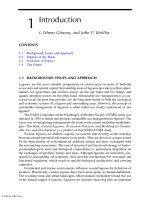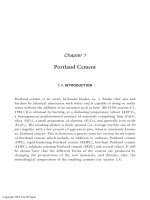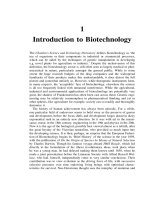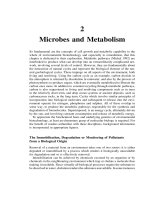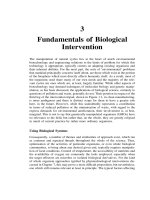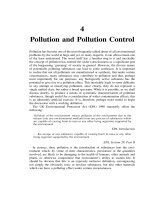Environmental Biotechnology - Chapter 1 pps
Bạn đang xem bản rút gọn của tài liệu. Xem và tải ngay bản đầy đủ của tài liệu tại đây (118.87 KB, 10 trang )
1
Introduction to Biotechnology
The Chambers Science and Technology Dictionary defines biotechnology as ‘the
use of organisms or their components in industrial or commercial processes,
which can be aided by the techniques of genetic manipulation in developing
e.g. novel plants for agriculture or industry.’ Despite the inclusiveness of this
definition, the biotechnology sector is still often seen as largely medical or phar-
maceutical in nature, particularly amongst the general public. While to some
extent the huge research budgets of the drug companies and the widespread
familiarity of their products makes this understandable, it does distort the full
picture and somewhat unfairly so. However, while therapeutic instruments form,
in many respects, the ‘acceptable’ face of biotechnology, elsewhere the science
is all too frequently linked with unnatural interference. While the agricultural,
industrial and environmental applications of biotechnology are potentially very
great, the shadow of Frankenstein has often been cast across them. Genetic engi-
neering may be relatively commonplace in pharmaceutical thinking and yet in
other spheres, like agriculture for example, society can so readily and thoroughly
demonise it.
The history of human achievement has always been episodic. For a while,
one particular field of endeavour seems to hold sway as the preserve of genius
and development, before the focus shifts and development forges ahead in dizzy
exponential rush in an entirely new direction. So it was with art in the renais-
sance, music in the 18th century, engineering in the 19th and physics in the 20th.
Now it is the age of the biological, possibly best viewed almost as a rebirth, after
the great heyday of the Victorian naturalists, who provided so much input into
the developing science. It is then, perhaps, no surprise that the European Federa-
tion of Biotechnology begins its ‘Brief History’ of the science in the year 1859,
with the publication of On the Origin of Species by Means of Natural Selection
by Charles Darwin. Though his famous voyage aboard HMS Beagle,whichled
directly to the formulation of his (then) revolutionary ideas, took place when
he was a young man, he had delayed making them known until 1858, when he
made a joint presentation before the Linnaean Society with Alfred Russell Wal-
lace, who had, himself, independently come to very similar conclusions. Their
contribution was to view evolution as the driving force of life, with successive
selective pressures over time endowing living beings with optimised charac-
teristics for survival. Neo-Darwinian thought sees the interplay of mutation and
2 Environmental Biotechnology
natural selection as fundamental. The irony is that Darwin himself rejected muta-
tion as too deleterious to be of value, seeing such organisms, in the language
of the times, as ‘sports’ – oddities of no species benefit. Indeed, there is consid-
erable evidence to suggest that he seems to have espoused a more Lamarckist
view of biological progression, in which physical changes in an organism’s life-
time were thought to shape future generations. Darwin died in 1882. Ninety-nine
years after his death, the first patent for a genetically modified organism was
granted to Ananda Chakrabarty of the US General Electric, relating to a strain of
Pseudomonas aeruginosa engineered to express the genes for certain enzymes in
order to metabolise crude oil. Twenty years later still, in the year that saw the first
working draft of the human genome sequence published and the announcement of
the full genetic blueprint of the fruit fly, Drosophila melanogaster, that archetype
of eukaryotic genetics research, biotechnology has become a major growth indus-
try with increasing numbers of companies listed on the world’s stock exchanges.
Thus, at the other end of the biotech timeline, a century and a half on from Ori-
gin of Species, the principles it first set out remain of direct relevance for what
has been termed the ‘chemical evolution’ of biologically active substances and
are commonly used in laboratories for in vitro production of desired qualities in
biomolecules.
The Role of Environmental Biotechnology
While pharmaceutical biotechnology represents the glamorous end of the market,
environmental applications are decidedly more in the Cinderella mould. The
reasons for this are fairly obvious. The prospect of a cure for the many diseases
and conditions currently promised by gene therapy and other biotech-oriented
medical miracles can potentially touch us all. Our lives may, quite literally, be
changed. Environmental biotechnology, by contrast, deals with far less apparently
dramatic topics and, though their importance, albeit different, may be every bit
as great, their direct relevance is far less readily appreciated by the bulk of
the population. Cleaning up contamination and dealing rationally with wastes
is, of course, in everybody’s best interests, but for most people, this is simply
addressing a problem which they would rather had not existed in the first place.
Even for industry, though the benefits may be noticeable on the balance sheet, the
likes of effluent treatment or pollution control are more of an inevitable obligation
than a primary goal in themselves. In general, such activities are typically funded
on a distinctly limited budget and have traditionally been viewed as a necessary
inconvenience. This is in no way intended to be disparaging to industry; it simply
represents commercial reality.
In many respects, there is a logical fit between this thinking and the aims
of environmental biotechnology. For all the media circus surrounding the grand
questions of our age, it is easy to forget that not all forms of biotechnology
involve xenotransplantation, genetic modification, the use of stem cells or cloning.
Introduction to Biotechnology 3
Some of the potentially most beneficial uses of biological engineering, and which
may touch the lives of the majority of people, however indirectly, involve much
simpler approaches. Less radical and showy, certainly, but powerful tools, just
the same. Environmental biotechnology is fundamentally rooted in waste, in its
various guises, typically being concerned with the remediation of contamination
caused by previous use, the impact reduction of current activity or the control of
pollution. Thus, the principal aims of this field are the manufacture of products in
environmentally harmonious ways, which allow for the minimisation of harmful
solids, liquids or gaseous outputs or the clean-up of the residual effects of earlier
human occupation.
The means by which this may be achieved are essentially two-fold. Environ-
mental biotechnologists may enhance or optimise conditions for existing biolog-
ical systems to make their activities happen faster or more efficiently, or they
resort to some form of alteration to bring about the desired outcome. The variety
of organisms which may play a part in environmental applications of biotech-
nology is huge, ranging from microbes through to trees and all are utilised on
one of the same three fundamental bases – accept, acclimatise or alter. For the
vast majority of cases, it is the former approach, accepting and making use of
existing species in their natural, unmodified form, which predominates.
The Scope for Use
There are three key points for environmental biotechnology interventions, namely
in the manufacturing process, waste management or pollution control, as shown
in Figure 1.1.
Accordingly, the range of businesses to which environmental biotechnology
has potential relevance is almost limitless. One area where this is most apparent
is with regard to waste. All commercial operations generate waste of one form or
another and for many, a proportion of what is produced is biodegradable. With
disposal costs rising steadily across the world, dealing with refuse constitutes
an increasingly high contribution to overheads. Thus, there is a clear incentive
for all businesses to identify potentially cost-cutting approaches to waste and
Figure 1.1 The three intervention points
4 Environmental Biotechnology
employ them where possible. Changes in legislation throughout Europe, the US
and elsewhere, have combined to drive these issues higher up the political agenda
and biological methods of waste treatment have gained far greater acceptance as a
result. For those industries with particularly high biowaste production, the various
available treatment biotechnologies can offer considerable savings.
Manufacturing industries can benefit from the applications of whole organ-
isms or isolated biocomponents. Compared with conventional chemical processes,
microbes and enzymes typically function at lower temperatures and pressures.
The lower energy demands this makes leads to reduced costs, but also has clear
benefits in terms of both the environment and workplace safety. Additionally,
biotechnology can be of further commercial significance by converting low-cost
organic feedstocks into high value products or, since enzymatic reactions are
more highly specific than their chemical counterparts, by deriving final substances
of high relative purity. Almost inevitably, manufacturing companies produce
wastewaters or effluents, many of which contain biodegradable contaminants, in
varying degrees. Though traditional permitted discharges to sewer or watercourses
may be adequate for some, other industries, particularly those with recalcitrant or
highly concentrated effluents, have found significant benefits to be gained from
using biological treatment methods themselves on site. Though careful moni-
toring and process control are essential, biotechnology stands as a particularly
cost-effective means of reducing the pollution potential of wastewater, leading to
enhanced public relations, compliance with environmental legislation and quan-
tifiable cost-savings to the business.
Those involved in processing organic matter, for example, or with drying,
printing, painting or coating processes, may give rise to the release of volatile
organic compounds (VOCs) or odours, both of which represent environmental
nuisances, though the former is more damaging than the latter. For many, it is
not possible to avoid producing these emissions altogether, which leaves treating
them to remove the offending contaminants the only practical solution. Especially
for relatively low concentrations of readily water-soluble VOCs or odorous chem-
icals, biological technologies can offer an economic and effective alternative to
conventional methods.
The use of biological cleaning agents is another area of potential benefit,
especially where there is a need to remove oils and fats from process equipment,
work surfaces or drains. Aside from typically reducing energy costs, this may
also obviate the need for toxic or dangerous chemical agents. The pharmaceutical
and brewing industries, for example, both have a long history of employing
enzyme-based cleaners to remove organic residues from their process equipment.
In addition, the development of effective biosensors, powerful tools which rely
on biochemical reactions to detect specific substances, has brought benefits to a
wide range of sectors, including the manufacturing, engineering, chemical, water,
food and beverage industries. With their ability to detect even small amounts
of their particular target chemicals, quickly, easily and accurately, they have
Introduction to Biotechnology 5
been enthusiastically adopted for a variety of process monitoring applications,
particularly in respect of pollution assessment and control.
Contaminated land is a growing concern for the construction industry, as it
seeks to balance the need for more houses and offices with wider social and
environmental goals. The reuse of former industrial sites, many of which occupy
prime locations, may typically have associated planning conditions attached
which demand that the land be cleaned up as part of the development process.
With urban regeneration and the reclamation of ‘brown-field’ sites increasingly
favoured in many countries over the use of virgin land, remediation has come
to play a significant role and the industry has an ongoing interest in identifying
cost-effective methods of achieving it. Historically, much of this has involved
simply digging up the contaminated soil and removing it to landfill elsewhere.
Bioremediation technologies provide a competitive and sustainable alternative
and in many cases, the lower disturbance allows the overall scheme to make
faster progress.
As the previous brief examples show, the range of those which may bene-
fit from the application of biotechnology is lengthy and includes the chemical,
pharmaceutical, water, waste management and leisure industries, as well as man-
ufacturing, the military, energy generation, agriculture and horticulture. Clearly,
then, this may have relevance to the viability of these ventures and, as was
mentioned at the outset, biotechnology is an essentially commercial activity.
Environmental biotechnology must compete in a world governed by the best
practicable environmental option (BPEO) and the best available techniques not
entailing excessive cost (BATNEEC). Consequently, the economic aspect will
always have a large influence on the uptake of all initiatives in environmental
biotechnology and, most particularly, in the selection of methods to be used in
any given situation. It is impossible to divorce this context from the decision-
making process. By the same token, the sector itself has its own implications for
the wider economy.
The Market for Environmental Biotechnology
The UK’s Department of Trade and Industry estimated that 15–20% of the
global environmental market in 2001 was biotech-based, which amounted to
about 250–300 billion US dollars and the industry is projected to grow by as
much as ten-fold over the following five years. This expected growth is due
to greater acceptance of biotechnology for clean manufacturing applications and
energy production, together with increased landfill charges and legislative changes
in waste management which also alter the UK financial base favourably with
respect to bioremediation. Biotechnology-based methods are seen as essential
to help meet European Union (EU) targets for biowaste diversion from land-
fill and reductions in pollutants. Across the world the existing regulations on
environmental pollution are predicted to be more rigorously enforced, with more
6 Environmental Biotechnology
stringent compliance standards implemented. All of this is expected to stimulate
the sales of biotechnology-based environmental processing methods significantly
and, in particular, the global market share is projected to grow faster than the
general biotech sector trend, in part due to the anticipated large-scale EU aid for
environmental clean-up in the new accession countries of Eastern Europe.
Other sources paint a broadly similar picture. The BioIndustry Association
(BIA) survey, Industrial Markets for UK Biotechnology – Trends and Issues, pub-
lished in 1999 does not quote any monetary sector values per year, but gives the
size of the UK sector as employing 40 000 people in 1998 with an average yearly
growth over 1995–98 of 20%. Environmental biotech is reported as representing
around 10% of this sector. An Arthur Anderson report of 1997 gives the turnover
of the UK biotech sector as 702 million pounds sterling in 1995/96, with a 50%
growth over three years. A 1998 Ernst and Young report on the European Life
Sciences Sector says that the market for biotechnology products has the poten-
tial to reach 100 billion pounds sterling worldwide by 2005. The Organisation
for Economic Cooperation and Development (OECD) estimates that the global
market for environmental biotechnology products and services alone will rise
to some US$75 billion by the year 2000, accounting for some 15 to 25% of
the overall environmental technology market, which has a growth rate estimated
at 5.5% per annum. The UK potential market for environmental biotechnology
products and services is estimated at between 1.65 and 2.75 billion US dollars
and the growth of the sector stands at 25% per annum, according to the Bio-
Commerce Data European Biotechnology Handbook. An unsourced quote found
on a Korean University website says that the world market size of biotechnology
products and services was estimated to be approximately 390 billion US dollars
in the year 2000.
The benefits are not, however, confined to the balance sheet. The Organisation
for Economic Cooperation and Development (OECD 2001) concluded that the
industrial use of biotechnology commonly leads to increasingly environmentally
harmonious processes and additionally results in lowered operating and/or capital
costs. For years, industry has appeared locked into a seemingly unbreakable cycle
of growth achieved at the cost of environmental damage. The OECD investigation
provides what is probably the first hard evidence to support the reality of biotech-
nology’s long-heralded promise of alternative production methods, which are eco-
logically sound and economically efficient. A variety of industrial sectors includ-
ing pharmaceuticals, chemicals, textiles, food and energy were examined, with a
particular emphasis on biomass renewable resources, enzymes and bio-catalysis.
While such approaches may have to be used in tandem with other processes for
maximum effectiveness, it seems that their use invariably leads to reduction in
operating or capital costs, or both. Moreover, the research also concludes that
it is clearly in the interests of governments of the developed and developing
worlds alike to promote the use of biotechnology for the substantial reductions
in resource and energy consumption, emissions, pollution and waste production
Introduction to Biotechnology 7
it offers. The potential contribution to be made by the appropriate use of biotech-
nology to environmental and economic sustainability would seem to be clear.
The upshot of this is that few biotech companies in the environmental sector
perceive problems for their own business development models, principally as a
result of the wide range of businesses for which their services are applicable,
the relatively low market penetration to date and the large potential for growth.
Competition within the sector is not seen as a major issue either, since the field
is still largely open and unsaturated. Moreover, there has been a discernible
tendency in recent years towards niche specificity, with companies operating in
more specialised subarenas within the environmental biotechnology umbrella.
Given the number and diversity of such possible slots, coupled with the fact that
new opportunities, and the technologies to capitalise on them, are developing
apace, this trend seems likely to continue. It is not without some irony that
companies basing their commercial activities on biological organisms should
themselves come to behave in such a Darwinian fashion. However, the picture
is not entirely rosy.
Typically the sector comprises a number of relatively small, specialist com-
panies and the market is, as a consequence, inevitably fragmented. Often the
complexities of individual projects make the application of ‘standard’ off-the-
shelf approaches very difficult, the upshot being that much of what is done must
be significantly customised. While this, of course, is a strength and of great
potential environmental benefit, it also has hard commercial implications which
must be taken into account. A sizeable proportion of companies active in this
sphere, have no products or services which might reasonably be termed suit-
able for generalised use, though they may have enough expertise, experience or
sufficiently perfected techniques to deal with a large number of possible sce-
narios. The fact remains that one of the major barriers to the wider uptake of
biological approaches is the high perceived cost of these applications. Part of
the reason for this lies in historical experience. For many years, the solutions to
all environmental problems were seen as expensive and for many, particularly
those unfamiliar with the multiplicity of varied technologies available, this has
remained the prevalent view. Generally, there is often a lack of financial resource
allocation available for this kind of work and biotech providers have sometimes
come under pressure to reduce the prices for their services as a result. Greater
awareness of the benefits of biotechnology, both as a means to boost existing
markets and for the opening up of new ones, is an important area to be addressed.
Many providers, particularly in the UK, have cited a lack of marketing expertise
as one of the principal barriers to their exploitation of novel opportunities. In
addition, a lack of technical understanding of biotech approaches amongst tar-
get industries and, in some cases, downright scepticism regarding their efficacy,
can also prove problematic. Good education, in the widest sense, of customers
and potential users of biological solutions will be one major factor in any future
upswing in the acceptance and utilisation of these technologies.
8 Environmental Biotechnology
Modalities and local influences
Another of the key factors affecting the practical uptake of environmental biotech-
nology is the effect of local circumstances. Contextual sensitivity is almost
certainly the single most important factor in technology selection and repre-
sents a major influence on the likely penetration of biotech processes into the
marketplace. Neither the nature of the biological system, nor of the application
method itself, play anything like so relevant a role. This may seem somewhat
unexpected at first sight, but the reasons for it are obvious on further inspection.
While the character of both the specific organisms and the engineering remain
essentially the same irrespective of location, external modalities of economics,
legislation and custom vary on exactly this basis. Accordingly, what may make
abundant sense as a biotech intervention in one region or country, may be totally
unsuited to use in another. In as much as it is impossible to discount the wider
global economic aspects in the discussion, disassociating political, fiscal and
social conditions equally cannot be done, as the following example illustrates. In
1994, the expense of bioremediating contaminated soil in the United Kingdom
greatly exceeded the cost of removing it to landfill. Six years later, with succes-
sive changes of legislation and the imposition of a landfill tax, the situation has
almost completely reversed. In those other countries where landfill has always
been an expensive option, remediation has been embraced far more readily.
While environmental biotechnology must, inevitably, be viewed as contextually
dependent, as the previous example shows, contexts can change. In the final anal-
ysis, it is often fiscal instruments, rather than the technologies, which provide the
driving force and sometimes seemingly minor modifications in apparently unre-
lated sectors can have major ramifications for the application of biotechnology.
Again as has been discussed, the legal framework is another aspect of undeni-
able importance in this respect. Increasingly tough environmental law makes a
significant contribution to the sector and changes in regulatory legislation are
often enormously influential in boosting existing markets or creating new ones.
When legislation and economic pressure combine, as, for example, they have
begun to do in the European Landfill Directive, the impetus towards a funda-
mental paradigm shift becomes overwhelming and the implications for relevant
biological applications can be immense.
There is a natural tendency to delineate, seeking to characterise technologies
into particular categories or divisions. However, the essence of environmental
biotechnology is such that there are many more similarities than differences.
Though it is, of course, often helpful to view individual technology uses as
distinct, particularly when considering treatment options for a given environ-
mental problem, there are inevitably recurrent themes which feature throughout
the whole topic. Moreover, this is a truly applied science. While the importance
of the laboratory bench cannot be denied, the controlled world of research trans-
lates imperfectly into the harsh realities of commercial implementation. Thus,
there can often be a dichotomy between theory and application and it is precisely
Introduction to Biotechnology 9
this fertile ground which is explored in the present work. In addition, the princi-
pal underlying approach of specifically environmental biotechnology, as distinct
from other kinds, is the reliance on existing natural cycles, often directly and in an
entirely unmodified form. Thus, this science stands on a foundation of fundamen-
tal biology and biochemistry. To understand the application, the biotechnologist
must simply examine the essential elements of life, living systems and ecological
circulation sequences. However engineered the approach, this fact remains true.
In many respects, environmental biotechnology stands as the purest example of
the newly emergent bioindustry, since it is the least refined, at least in terms of
the basis of its action. In essence, all of its applications simply encourage the
natural propensity of the organisms involved, while seeking to enhance or accel-
erate their action. Hence, optimisation, rather than modification, is the typical
route by which the particular desired end result, whatever it may be, is achieved
and, consequently, a number of issues feature as common threads within the
discussions of individual technologies.
Integrated Approach
Integration is an important aspect for environmental biotechnology. One theme
that will be developed throughout this book is the potential for different bio-
logical approaches to be combined within treatment trains, thereby producing
an overall effect which would be impossible for any single technology alone
to achieve. However, the wider goal of integration is not, of necessity, confined
solely to the specific methods used. It applies equally to the underpinning knowl-
edge that enables them to function in the first place and an understanding of this
is central to the rationale behind this book. In some spheres, traditional biology
has become rather unfashionable and the emphasis has shifted to more exciting
sounding aspects of life science. While the new-found concentration on ‘ecolog-
ical processes’, or whatever, sounds distinctly more ‘environmental’, in many
ways, and somewhat paradoxically, it sometimes serves the needs of environ-
mental biotechnology rather less well. The fundamentals of living systems are
the stuff of this branch of science and, complex though the whole picture may be,
at its simplest the environmental biotechnologist is principally concerned with a
relatively small number of basic cycles. In this respect, a good working knowl-
edge of biological processes like respiration, fermentation and photosynthesis,
a grasp of the major cycles by which carbon, nitrogen and water are recycled
and an appreciation of the flow of energy through the biosphere must be viewed
as prerequisites. Unsurprisingly, then, these basic processes appear throughout
this book, either explicitly or tacitly accepted as underpinning the context of the
discussion. The intent here has been neither to insult the readership by parading
what is already well known, nor gloss over aspects which, if left unexplained, at
least in reasonable detail, might only serve to confuse. However, this is expressly
not designed to be a substitute for much more specific texts on these subjects, nor
10 Environmental Biotechnology
an entire alternative to a cohesive course on biology or biochemistry. The inten-
tion is to introduce and explain the necessary aspects and elements of various
metabolic pathways, reactions and abilities as required to advance the reader’s
understanding of this particular branch of biotechnology.
A large part of the reasons for approaching the subject in this way is the fact
that there really is no such thing as a ‘typical’ environmental biotechnologist.
Practitioners come into the profession from a wide variety of disciplines and by
many different routes. Thus, amongst their ranks are agronomists, biochemists,
biologists, botanists, enzymologists, geneticists, microbiologists, molecular biol-
ogists, process engineers and protein technologists, all of whom bring their own
particular skills, knowledge base and experiences. The applied nature of envi-
ronmental biotechnology is obvious. While the science underlying the processes
themselves may be as pure as any other, what distinguishes this branch of bio-
logical technology are the distinctly real-life purposes to which it is put. Hence,
part of the intended function of this book is to attempt to elucidate the former in
order to establish the basis of the latter. At the same time, as any applied scientist
will confirm, what happens in the field under operational conditions represents
a distinct compromise between the theoretical and the practically achievable.
At times, anything more than an approximation to the expected results may be
counted as something of a triumph of environmental engineering.
Closing Remarks
The celebrated astronomer and biologist, Sir Fred Hoyle, said that the solutions
to major unresolved problems should be sought by the exploration of radical
hypotheses, while simultaneously adhering to well-tried and tested scientific tools
and methods. This approach is particularly valid for environmental biotechnology.
With new developments in treatment technologies appearing all the time, the list
of what can be processed or remediated by biological means is ever changing. By
the same token, the applications for which biotechnological solutions are sought
are also subject to alteration. For the biotech sector to keep abreast of these
new demands it may be necessary to examine some truly ‘radical hypotheses’
and possibly make use of organisms or their derivatives in ways previously
unimagined. This is the basis of innovation; the inventiveness of an industry is
often a good measure of its adaptability and commercial robustness.
References
Organisation for Economic Cooperation and Development (2001) The Application
of Biotechnology to Industrial Sustainability,OECD,Paris.
Walker P.M.B. (ed.) (1992) Chambers Science and Technology Dictionary,Cham-
bers, Edinburgh.



